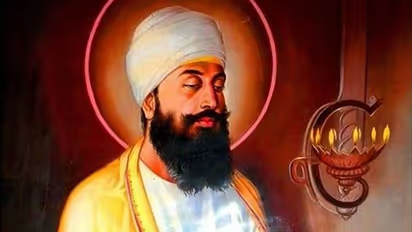Guru Teg Bahadur Martyrdom Day: Do you know why the Sikh Guru was called 'Hind Di Chadar'?

Synopsis
Guru Teg Bahadur was instrumental in resisting the forced conversions to Islam under the reign of Mughal emperor Aurangzeb. In many ways, Guru Teg Bahadur's preachings still influence many people.
Million of Sikh community followers are observing the 'Martyrdom Day' of Guru Teg Bahadur, the ninth Guru of the Sikh community. Revered by many as 'Hind Di Chadar' or Protector of Hindu Religion, Guru Teg Bahadur was instrumental in resisting the forced conversions to Islam under the Mughals. He was publicly beheaded in Delhi in 1675 on Mughal emperor Aurangzeb's orders for refusing to convert to Islam. But his supreme sacrifice for the cause of human dignity, liberty and freedom of worship inspired millions. In many ways, Guru Teg Bahadur's preachings still influence many people. Let's take a look at the revered leader on his Shaheedi Divas.
* Guru Teg Bahadur was born on April 1, 1621, in Amritsar. His original name was Tyag Mall. He was later bestowed the name of Teg Bahadur (the fearless master of the sword) by his father, Guru Hargobind, following the battle of Kartarpur in April 1635. He was only 14 then.
* Before Guru Hargobind passed away in 1644, he told Teg Bahadur that he would have to propagate the teaching of Guru Nanak. Two decades later, he took over as the Guru.
* According to some accounts, Guru Teg Bahadur was an avid traveller. He undertook long and arduous trips to meet Sikh Sangats who were residing in far-flung areas of Uttar Pradesh, Bihar, Bengal and Assam. Because of his visits, Patna became the most sacred place in eastern India for the Sikh community. The origin of the Gurudwara Shri Guru Ka Bagh Sahib in Patna is based around the legend that when Guru Teg Bahadur returned to Patna after his four-year-long travel to Eastern India, he stayed in this location belonging to then nobles of Patna.
* Many hymns in Granth Sahib are attributed to Guru Teg Bahadur. Research suggests that 116 shabads, 15 ragas, and his bhagats are credited with 782 compositions that are part of bani in Sikhism.
* Historians say that after Aurangzeb's fanatical reign began, he unleashed a wave of horror across the country. The ruthless destruction of temples, forcible conversions and discrimination became the order of the day. It was then that a group of 500 Kashmiri Pandits went to Anandpur Sahib to seek help from Guru Teg Bahadur, who did not disappoint them. Guru Teg Bahadur assured them that he would oppose the forced conversions being undertaken at Aurangzeb's behest.
* Guru Teg Bahadur was arrested for his defiance and tortured for five days. However, he refused to convert. Aurangzeb tried every brutal way to get the Guru to convert. This included burning alive his followers in front of his eyes. But Guru Teg Bahadur did not budge. The frustrated Mughal emperor then ordered the Sih Guru's beheading at Chandni Chowk in broad daylight.
* Gurudwara Sis Ganj Sahib, one of the oldest and most iconic Sikh shrines in Delhi, was first established in 1783 to mark the martyrdom of the Guru Teg Bahadur. It marks the site where the Sikh Guru was beheaded.
Also Read
Mega wargames on along Line of Control and Line of Actual Control
India to release 5 million barrels of crude oil from its emergency stockpile in tandem with US
Stay updated with the Breaking News Today and Latest News from across India and around the world. Get real-time updates, in-depth analysis, and comprehensive coverage of India News, World News, Indian Defence News, Kerala News, and Karnataka News. From politics to current affairs, follow every major story as it unfolds. Get real-time updates from IMD on major cities weather forecasts, including Rain alerts, Cyclone warnings, and temperature trends. Download the Asianet News Official App from the Android Play Store and iPhone App Store for accurate and timely news updates anytime, anywhere.